Terny
In five months, from January 1st to June 4, Russia captured 198 square kilometers. On June 4th, the 3rd Corps assumed command of 120 km of the front line, which is the entire front line shown in the map below. Because Syrsky did everything in his powers to ruin Drapaty’s reform of the ZSU and, de-facto, cancelled his re-organisation of useless tactical commands and tactical groups into corpses, the 3rd Corps nowadays only has two brigades: the 3rd Assault Brigade and the 60th Mechanized Brigade.
‘But’, hey: it doesn’t matter. Syrsky was so kind to grant the command of the 3rd Assault Corps the ‘operational’ control several over other units in that sector. It’s a total of about eight additional brigades and maybe seven separate or detached battalions - which are now operating… ho-hum… ‘autonomously’. See: without Syrsky’s micromanagement.
Now pay attention: this ad-hoc organisation is in the process of being attacked by three separate Russian armies, the 20th and 25th Combined Arms Armies and the 1st Tank Army.
The 3rd Corps immediately changed how the units fought. The 3rd Assault brigade spread its forces throughout 60 km of the front. It used its troops to ‘corset’ those of other units: to act as cadres for training other units, to make them fight in the same, or at least similar, fashion. Elsewhere, Syrsky’s common practice is to throw elements of different brigades piecemeal into counter attacks. Correspondingly, lots of brigade-commanders have ‘learned’ to detach their sub-units in order to plug holes in neighboring sectors. In the sector for which the 3rd Corps is responsible, nowadays, no one breaks up a unit. No one counter attacks without reconnaissance, preparation and coordination with adjacent units, artillery and drones, even if it’s a platoon-sized attack. Chaos is replaced by discipline and teamwork. Any positions that are surrounded are supported and sustained.
Because the Corps commander now has the authority to promote or fire subordinates, and because 3rd Brigade cadres are widely spread - and respected - throughout the front, false reports and lying about the situation have stopped. With accurate data, each brigade receives small, but planned replenishment of men and ammo, allowing commanders to depend on their resources and plan accordingly. Normally, it might be months before receiving replacements and commanders had to be conservative with their operations because they didn’t know how much they’d lose before they were replaced. But, there’s no denial: spreading out the 3rd Brigade as cadres is a long-term, steady exception.
This isn’t a miraculous transformation, it is simply a competent execution of standard battlefield operations. As a result, the rate of Ukrainian casualties in the six weeks that the 3rd Corps assumed command of the Terny sector is half of what it was from January 1st to June 4th. Russian casualties are 7-10 times higher than Ukrainian casualties.
This is the value of standard organization combined with competent leadership and trust in the initiative of subordinates. If this would have been replicated across the 1300 km of the frontlines in this war, Russia will not be able to sustain the conflict without significant changes of its own. Unfortunately, this is simply not the case. Thanks to Zele/Yermak, Syrsky & Buddies.
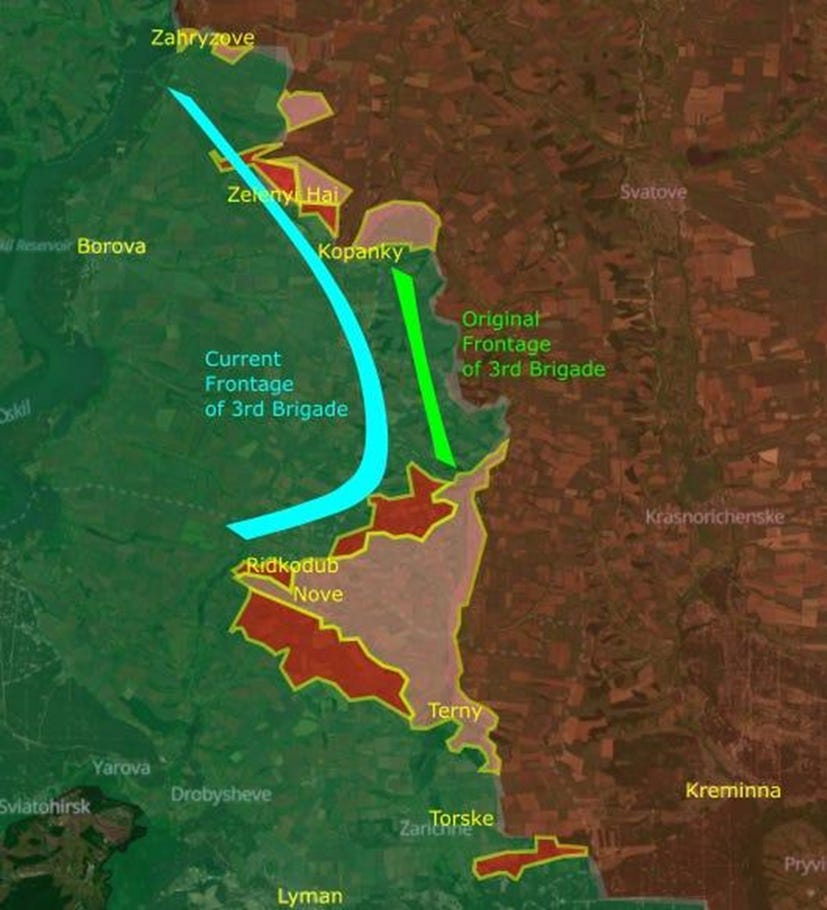
DeepState’s map showed that the Russians made huge gains from January 1st to June 4th (shown in pink) and additional gains from June 4th to August 2nd (shown in red). The 3rd Corps is now responsible for all the fronts shown on this map.
Russia entered Torske and the 63rd Brigade was trying to push them out with drones and tanks. The brigade also cleared a trench line. Russian infantry have been sent from the rear area into assaults with supplies, including land mines, and if a drone hits one of those soldiers it could wipe out the entire group, and on occasion, it has. Mines dropped by drones eliminate all but one Russian motorcyclist, and when he tries to walk away he steps on a mine.
Andriy Biletsky’s transformation from a civilian to corps commander is an indication of his organizational and leadership skills. He is also proud of his unit and skilled at public promotion, which produces donations and volunteers to join his unit. He stated that he hadn’t received an FPV drone from the government in three months and it was difficult to cover the 3rd Brigade’s sector. Biletsky said that in some periods, the state provides 30-40% of the brigade’s drones, which he says is a significant share. He also said that the brigade’s needs are partially covered by donations and volunteers and that the brigade now has a “curator” (a patron?) who helps financially. He also said that the system is working now.
The army decided to correct the record, which also illuminates some functions of the supply chain:
The Logistics Forces provide the brigades with a list of available equipment and vehicles. The 3rd Brigade’s requests were fulfilled. Between January 1 and May 27, 2025, the 3rd Brigade received 7,992 drones, but the drone types were not specified. (It is possible that none of them were FPV drones).
When a brigade needs equipment that is not available in government stockpiles, they submit an application to the Ministry of Defense and receive funding to make purchases of the needed equipment. This is how the 3rd Brigade was funded in May. As of May 28th, the brigade had used 57% of the funding.
***
Siversk
Here comes a good example for ‘modern day capabilities of the Russian Armed Forces’: the Russians have launched an assault - with 6 tanks, 3 different APCs, 6 MT-LBs, an armored recovery vehicle, 12 civilian vehicles, 2 ATVs and 41 motorcycles.
….the kind of ‘mechanised onslaught’ - most of NATO is diligently browning its underwear about. So much so, they are ‘incapable’ of sending significant reinforcements in heavy weapons systems, and/or more ammunition to Ukraine. Because, you know, it’s 1000% sure Putin is going to attack NATO as next. In a matter of weeks, months, a year, or two or five… depending on the author of the highly authoritative assessment in question…
Whatever…
The 54th and 81st Brigades used mines, drones and artillery to destroy all of the vehicles except an MT-LB, one car and the armored recovery vehicle. 48 soldiers were reported killed while 69 were wounded. The Russians did manage to advance up to 1500 meters.
A rare tank engagement as a Ukrainian tank fires point blank on a Russian vehicle armored against drones. It was later finished off by drones. A Russian infantryman tries to cross concertina wire and a drone hits him. Yet another Russian assault was repelled, too.
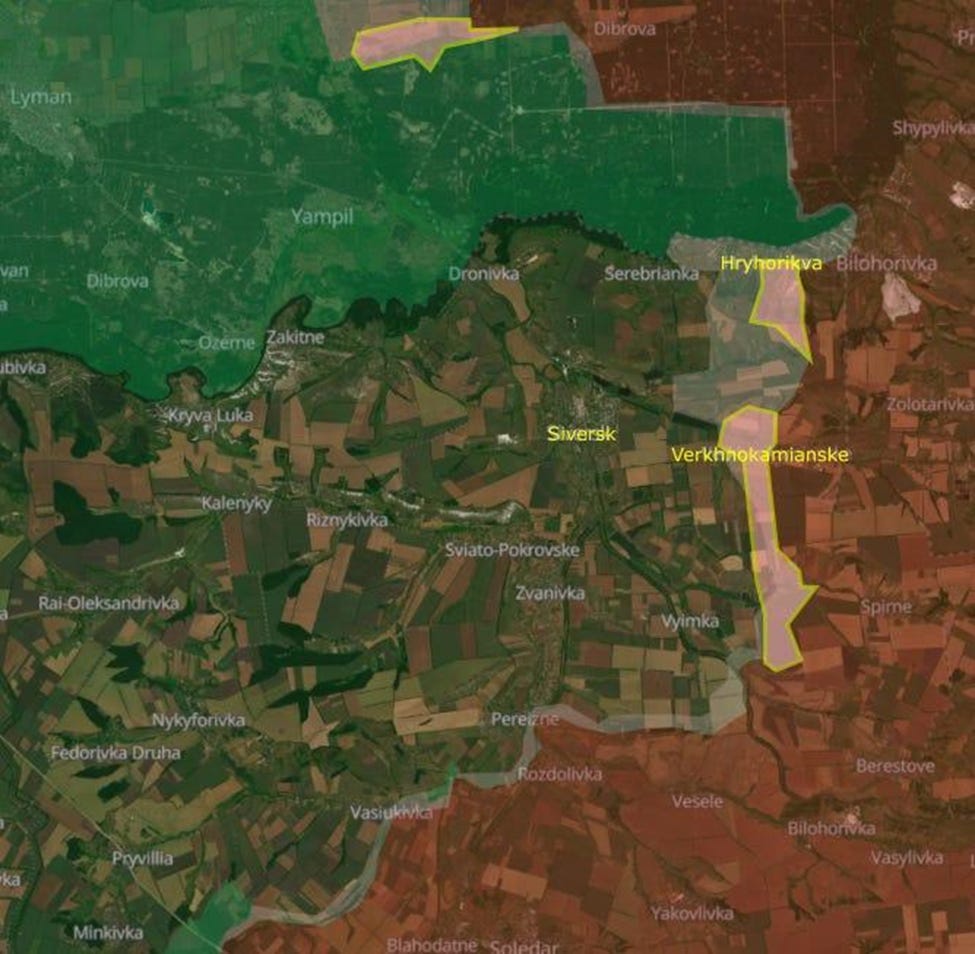
***
Kostiantynivka
Oleksandro-Kalynove was fully occupied by the Russians. Russian positions on top of a slag heap are attacked. Ukrainians in Shcherbynivka are observed and attacked. The 7th Rapid Response Corps attacks Russians in Poltavka. The Rubicon drone unit attacks Ukrainians, vehicles and multiple aerial and ground drones in Yablunivka. Russia claims an airstrike destroyed a drone team from the 28th Brigade in Pleshchiikva.
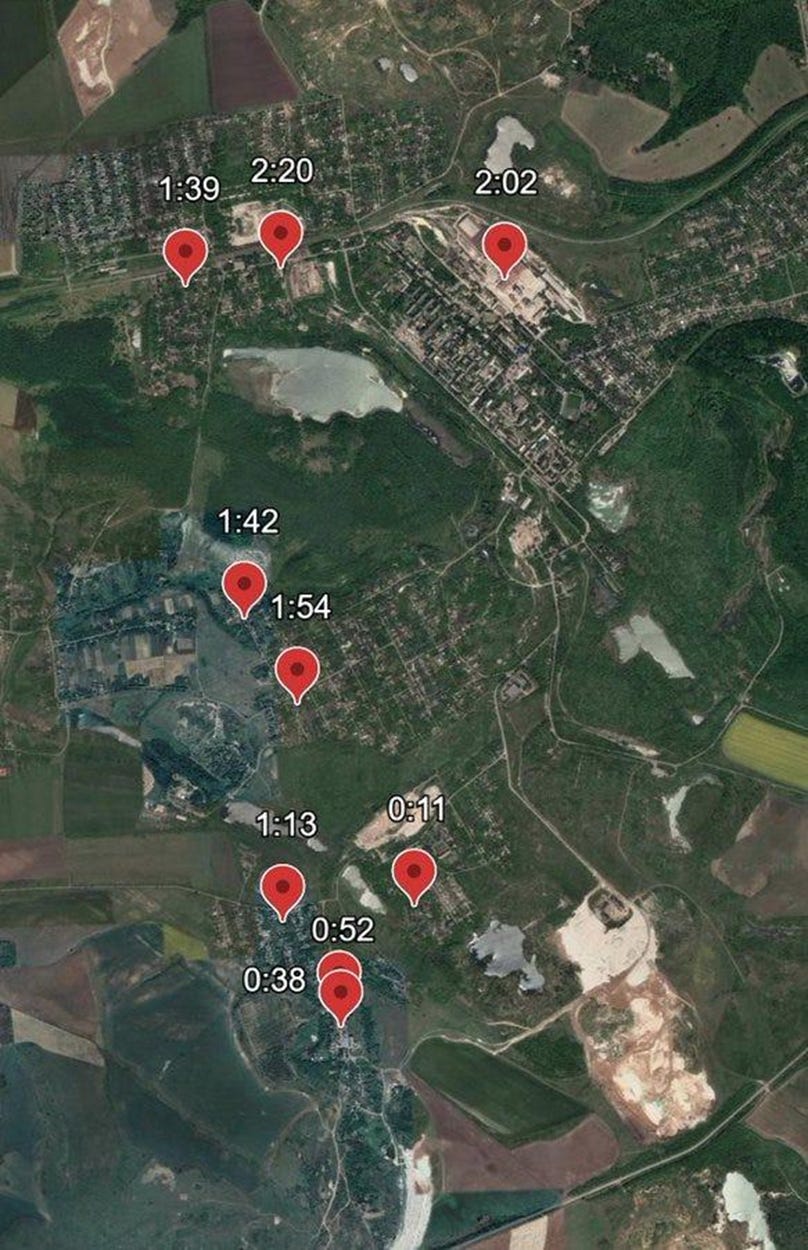
Based on the multiple flag raisings, Russia has taken 90% of Chasiv Yar. The position at the 2:02 mark in the video has been in Russian hands since May.
***
Pokrovsk
Russia’s main effort continues to be northeast of Pokrovsk but their advances have slowed, partly because of limited Ukrainian counter attacks. Small infiltration teams continue to move into Pokrovsk to be eliminated. Logistical vehicles on both sides are being heavily attacked by drones.
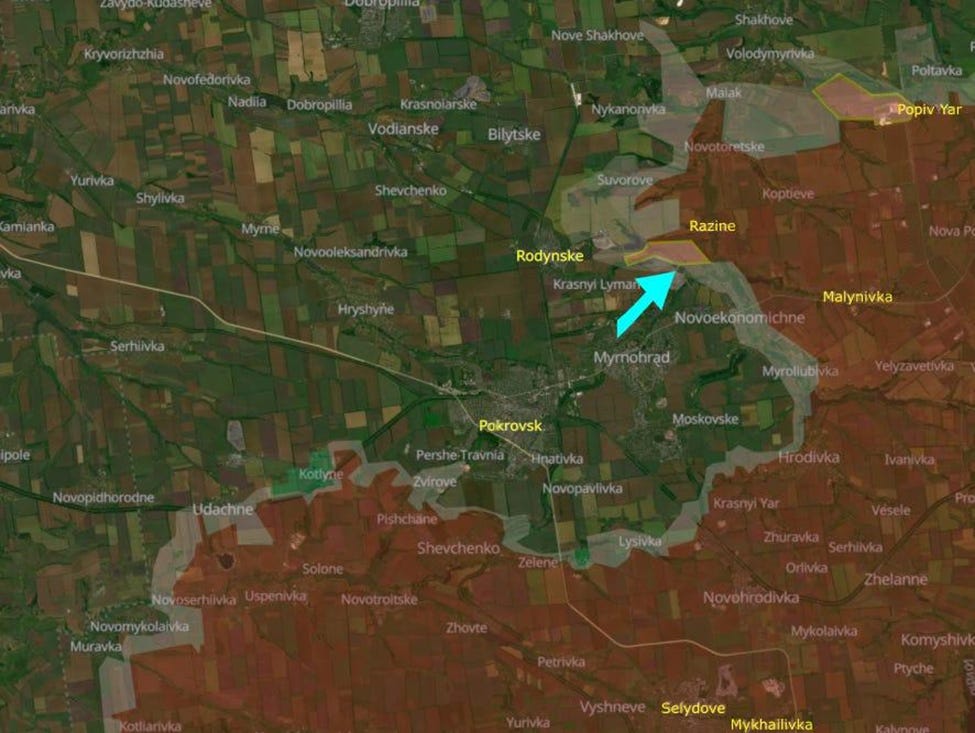
Russian drones find a T-64. The 68th Jaegers Brigade hits several Russian vehicles near Selydove, and more logistical vehicles are hit 3 km to the east in Mykhailivka. A Russian airstrike in Rodynske tries to pave the way for Russia’s continued advance. Russians continue to infiltrate the thin lines and advance into Pokrovsk in small groups. This group was eliminated by the 25th Airborne Brigade. Russian vehicles are eliminated near Malynivka. A Ukrainian vehicle speeds along a netted road north of Pokrovsk.
***
Komar
Despite limited Ukrainian counter attacks, though thanks to Syrsky’s superior skills as strategist and tactician, this sector remains unstable: there is no corps-command level of organisation, and no coherent, coordinated defense.
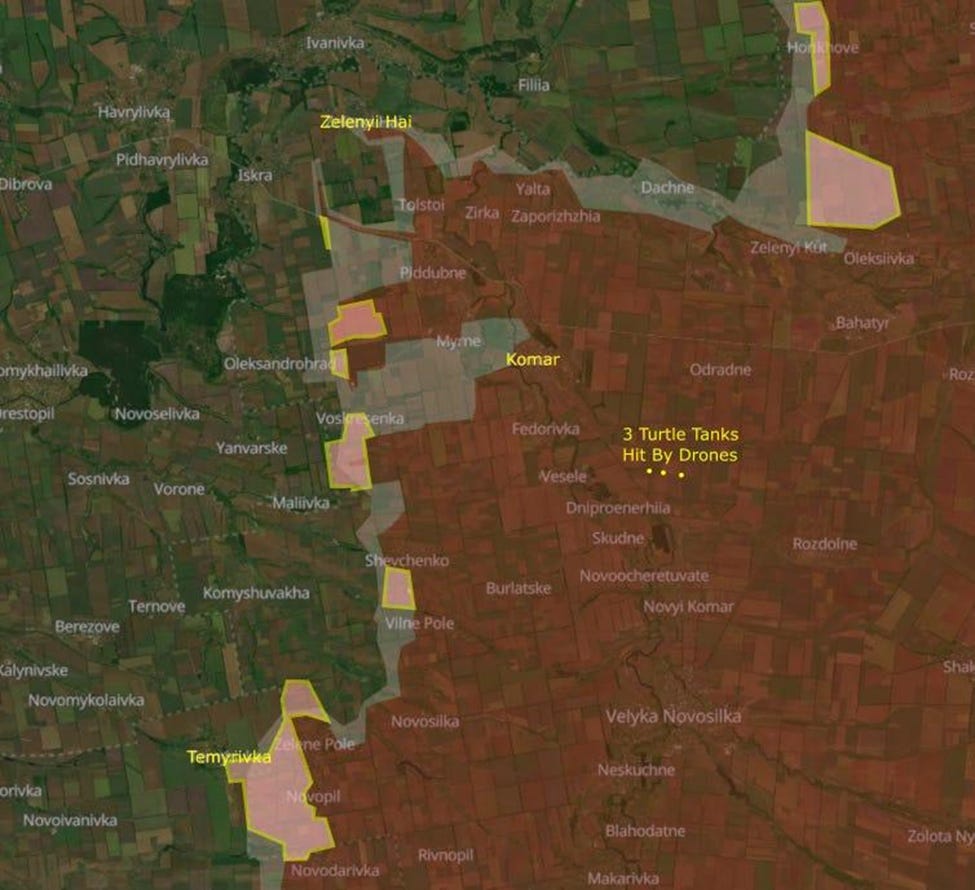
The 46th Brigade attacks multiple Russian targets north and east of Komar. Supported by drones, artillery and airstrikes, the village of Temirovka was occupied by Russia. Three turtle tanks are destroyed by the 414th Magyar Regiment, which was primarily supporting Pokrovsk 40 km to the north. A day after the Russians raised their flag in Zelenyi Hai, the Ukrainians did the same thing at the same location.
***
Zaporizhzhia
Ukrainian targets near Orekhovo are attacked. Russian infantry advancing towards Stepnorhirsk two weeks ago were eliminated. A Ukrainian counter attack pushed into northern Kamianske soon after and the lines were static this week.
The Steppe Wolves Company was founded at the beginning of the 2022 invasion by veterans of the 2014 invasion. They started off as an infantry unit but received an automatic grenade launcher and captured Russian mortars. Then volunteers built a rocket launcher on a truck and they became a rocket artillery unit that also uses drones. This is probably just as well because infantry is hard on old men and most of the soldiers in the unit are over 60. The commander is 68 and goes by the name of “Grandpa.” They also have younger men that were deemed medically unfit for combat.
Most volunteer units became part of the regular army, but the army rejected this unit and didn't support them. Official army units provide them with rockets that misfire because they are not allowed to restore them for safety reasons. The Steppe Wolves collect, repair and fire them because they don’t have to follow the same rules. The rest of their equipment is paid for by donations. Zelensky just signed a bill that allows soldiers over 60 to serve if they volunteer. It is possible that this might change the status of the Steppe Wolves company from a volunteer organization reliant on donations to a state-supported military unit. If so, they will hopefully be allowed to continue repairing rockets.
***
(…to be continued…)
This text is published with the permission of the author. First published here.